#Fehrbelliner Platz
Explore tagged Tumblr posts
Text

U-Bahnhof Fehrbelliner Platz, Berlin, 25
#freshfrompoland#bnw#black and white#bnw photography#canon5dmarkiii#berlin#U-Bahnhof Fehrbelliner Platz#Berlin#fehrbelliner platz#modern architecture#popart#pop art architecture#modernism#70s#diptych#conceptual photography#fotografia#polish photographer
6 notes
·
View notes
Text
Saturday 11 July 1998 - First time across the Oberbaumbrücke into East Berlin - Alexanderplatz and the world clock - Love Parade from 2 PM to 9 PM - supper at Escados and a long S-Bahn ride home to Nikolassee
11 July 1998 Love Parade in Berlin
Hi everybody,
Today 20 years ago, is part two of three, of the weekend in Berlin. It was also the day of the Love Parade 1998 - hence the hearts from my last post. It would not start until about 2 PM on Straße des 17 Juni, so I could get some sightseeing done before that and still take the U-Bahn.
The night was not too bad. My other roommates were not particularly noisy. The temperature was fair, about the low 50s by 7 AM. The showers were located in the hall.
My hostel had a breakfast room and breakfast was complimentary. It was the usual kind of breakfast at a typical Deutsches Jugendgästehaus, breads, cheese, butter, jam, hazelnut spread, sliced deli meats, orange juice, coffee and tea. I spent about half an hour. Then I went back to my room to get enough film for sightseeing. What I did not know was, I should have packed an extra camera battery. With the Samsung Evoca 115, it does not use conventional batteries. It uses a special U-Shaped battery about 5 volts called a "CR123". Will talk more about that for Sunday the 12th July. Then I walked the half mile to the Nikolassee train station but did not board a train, but a bus. This was because I wanted to go to Krumme Lanke along the U-1 into downtown and then take the S-Bahn from Heidelberger Platz to Innsbrucker Platz and take the U-4 to Nollendorfplatz. As for the Berlin U-Bahn map, please bear with me, as the lines have been reconfigured in the past twenty years that I last visited on my own, so I will likely mention the lines I remember from back then, rather than refer to the current line structure. As long as I still had the 72 hour pass, I did not need to worry about any "Fahrscheinkontrolle" that charged 80 D-Mark for not having a valid ticket.
I took a double decker bus from Nikolassee to the Krumme Lanke U-Bahn station and took the U-1 to Heidelberger Platz. The line ran at-grade up to Podbielskialle and went underground for two more stops. I had to come out of the tunnel for the S-41 that went to Innsbrucker Platz. The entire U-4 is still underground as it was in 1998. When the train arrived in Nollendorfplatz, there were two underground levels and one elevated one. That is what makes Nolledorfplatz unique. I went farther on the U-1 to Warschauer Straße, across the Spree by the Oberbaumbrücke. I believe I already mentioned, that up to 1995, the U-1 terminated only at Schlesisches Tor on the east, as that was where the wall was, and Warschauer Straße happened to be in the Soviet-controlled "East Zone". Many of the stations in the East Zone in 1998 appeared to be preserved as they existed in the Cold War, but have in the last twenty years been renovated, so if you happened to be born after 1989, you might not be able to recognize which stations were in the East Zone and which were in the Allied sectors. Allied being the USA, UK and France. It was a profound feeling to see the Warschauer Straße station, as it was cut off from the rest of the U-Bahn network for decades.
I had to walk across a pedestrian bridge at Warschauer Straße to be able to access the S-Bahn line. I wanted to see Alexanderplatz, the tower and the interesting world clock that must have 24 faces. The clock for many years did not have Tel Aviv or Jerusalem mentioned until that was changed in 1997, as it was GDR policy to not recognize the existence of Israel. I think The Bourne Supremacy had a scene in that particular square years later. I found a place where I might want to eat dinner, the Escados steak restaurant. They would be open until very late, I guess just before midnight, so I made a point to come back later that evening.
After seeing Alexanderplatz, I wanted to go back to West Berlin, and the Checkpoint Charlie museum. To get there from Alexanderplatz, I needed to take the U-2 to Stadtmitte and then south to Kochstraße by U-6. In the Cold War, the U-2 was an operating line on both sides of the wall. However the U-6 had several "ghost stations" that had just the lights dimly lit while the trains just passed through and did not reopen until after Reunification.
What luck, when I arrived at Kochstraße, the location of the iconic Checkpoint Charlie border crossing, the eponymous museum was open that day, so I decided to go inside for an hour or so. It was very interesting inside, with so much Cold War memorabilia. There was a Trabant that had a secret compartment to smuggle out people from East Germany to the West. And yes there was a controversial painting of Erich Honecker and Mikhail Gorbatchev, I will not go into any detail, you might look it up for yourself. As I had my passport with me, I paid 2.50 D-Mark to get a historical East Berlin border crossing stamp.
I think at Alexanderplatz, during the Cold War, that was one of the official border crossings for the U-Bahn and S-Bahn. One of the rules for entering East Berlin from West Berlin, was that you would have to change 25.00 D-Mark into 25 Ostmark. More information about the Ostmark at https://en.wikipedia.org/wiki/East_German_mark. And all the Ostmark was required to be spent before returning to the West. Because the cost of living in East Berlin as compared to West Berlin was so cheap, it made spending money difficult. One way to tell the Ostmark from the D-Mark, is that the Ostmark coins were made out of lighter metal than the D-Mark coins. There were also Intershops that accepted only hard currency and sold western wares. All I am aware of, is what my high school German teacher taught in class, and also other peoples' experiences.
After visiting the Checkpoint Charlie Museum, it was getting close to 1 PM. I stopped at a Kaiser Tengelmann store to buy food to make sandwiches, as I wanted to save money for a nice steak at Escados later. I love my Lyoner and Blutwurst so I bought some of that with slices of good looking white cheese, and some more soda cans. After that, I went on to Alexanderplatz, and then walked along Unter den Linden past the Berliner Dom and the then-standing Palast der Republik. The Palast der Republik was up to 1990, the parliament building for the East German government. Appearancewise, the Palast der Republik was made out of brownish copper and similarly tinted glass. It was a postwar brutalist style. People were gathering east of the Brandenburger Tor, as the Lovemobiles with the loud music were along Straße des 17 Juni.
So what is the Love Parade supposed to be? It was started in 1989 by DJ Dr Motte as a non-partisan political demonstration for peace and international understanding. And a great deal of electronic music which evolved from that of Kraftwerk. The Love Parade drew in later years up to 2003, about a million participants. To have a successful Love Parade, it is necessary to obtain funding and sponsors. In 2004 it was starting to be difficult to find sponsors and also the required permits in a timely manner. As for the music variety, I think there were 20 Lovemobiles in total, DJ Motte was at the head, there were others like DJ Marusha, Paul Van Dyk, Sven Väth, and Da Hool
Two of the drawbacks are, one of which, getting inadvertently dirty as a result of others drinking on the streets - glass was allowed as was aluminum and plastic, so it was necessary to watch one's step around areas where glass bottles were broken. There must have been an inch of garbage along the Straße des 17 Juni on average. I would not want to be part of the sanitation crew the next morning. Also, 11th July 1998 was one of the days that Germany had forgotten about its Mehrwegflasche recycling scheme - sad. The other drawback is if you do not have proper ear protection, you might have a horrible ringing of the ears. Foam earplugs were given out for free (someone donated for a bulk of them). Also during the Street Parade, the weather did not cooperate very well. Though it was in the upper 60s to lower 70s, there were periods of drizzle, alternating with periods of sunshine, and the DJs took special care to protect their equipment, so the music would last well into the late hours of about 10:30 or 11 PM.
The Love Parade was very large, in comparison to the little Marlboro cigarette garden parties from 1997 that I attended July 1997 in Hamburg and Munich, similar attire as the Love Parade, turnout of a thousand people each at most. Statistics show that there were 800,000 participants for 1998, so good turnout.
Recommended videos Da Hool - Meet her at the Love Parade https://www.youtube.com/watch?v=KO4y3nkJXDA Dr Motte & Westbam - One world, one future (the theme for the 1998 Love Parade in Berlin) https://www.youtube.com/watch?v=CDJ20spGymE
There have to be about a dozen Love Parade 1998 videos online, some lasting as long as six whole hours. I leave it to you to decide whether to watch those, especially if you are on a mobile data plan – be careful of how much bandwidth you use unless you’re on Wifi or ethernet.
I have to give the cleanup crew, security and first responders compliments on their professionalism. There was a little bit of humor when an ambulance was driving through the Straße des 17 Juni, and he said "Please clear the street. You know how to do that, right? We all went to school didn't we?". Then some silly person shouted "Not I! Not I!". Both exchanges were in German.
The next such parade I would attend would be the Street Parade, on 8th August 1998 in Zürich. That had a good turnout. I will tell more about it early next month.
I got tired about 10 PM and thought it was time for dinner. I had to walk past the Brandenburger Tor, along Unter den Linden to Alexanderplatz. Escados was still open for late dinner. I ordered a 5 ounce steak with chili and summer vegetables, and had a Berliner Kindl beer with it. It was a fairly relaxing dinnertime after a long afternoon and evening with loud electronic music. But it was fun nonetheless.
To return to the hostel, I should have taken the direct S-Bahn to Nikolassee, but I chose a different route. I took a line 100 bus to Rosenthaler Platz to catch the U-8. This was part of the U-8 Ghost Station line in East Berlin, up to Gesundbrunnen which was considered to be in West Berlin. Then I took the S-1 "the long way" back to Nikolassee. Somehow Ingo Ruff's voice put me to sleep until about Mexikoplatz. I made it back to the hostel about 11:45 PM and I went to sleep.
The next day I would have to check out and make my way home to Munich. I did not know about the Third Place match for FIFA 1998, but I later found out Croatia beat the Netherlands 2 to 1.
Tomorrow, Part 3, including Spandau and my impressions of Cold War Berlin’s U-Bahn line U-5.
Gute Nacht, bis morgen.
#Germany#Berlin#Deutschland#Kaisers Verbrauchermarkt#Jugendgästehaus am Wannsee#U1#Onkel Toms Hütte#Fehrbelliner Platz#Warschauer Straße#Oberbaumbrücke#Märkisches Museum#Krumme Lanke#Schlesisches Tor#Nollendorfplatz#Innsbrucker Platz#Alexanderplatz#Tel Aviv#Jerusalem#Bourne Supremacy#Checkpoint Charlie#Kochstraße#ghost station#Cold War#East Germany#GDR#DDR#Erich Honecker#East Berlin#Palast der Republik#Unter den Linden
0 notes
Text

Berlin Wilmersdorf
U-Bahnhof Fehrbelliner Platz
Canon EF 35mm f/1.4L USM@Canon EOS 6D
#Canon EOS 6D#Canon EF 35mm f/1.4L USM#germany#Deutschland#Berlin#Wilmersdorf#U-Bahnhof Fehrbelliner Platz#architecture#Architektur#subway#underground#public transportation#ÖPNV#BVG#urban#city#metro#staircase#Treppe#geometry#retro#vintage#colors#colours#Farben
0 notes
Text

2024 by lavenderandpine
© tag lavenderandpine
Object data
Architect: Rainer G. Rümmler
Year of construction: 1967–1971
Location: Fehrbelliner Platz, Berlin, Berlin, Germany
#lavenderandpine#photooftheday#street photography#fehrbellinerplatz#berlin#fujifilm#fujifilm x100v#original photographers#nostalgie#nostalgia#nostaligiacore#2024#berlin2024#Amateure photography#architecture#1971#1967–1971
13 notes
·
View notes
Text
0 notes
Photo

half and half
berlin wilmersdorf, 2017
#architecture#berlin#colour blocking#fehrbelliner platz#graphical#red#urban#wilmersdorf#yellow#Photographers on tumblr#Original photographers
45 notes
·
View notes
Photo
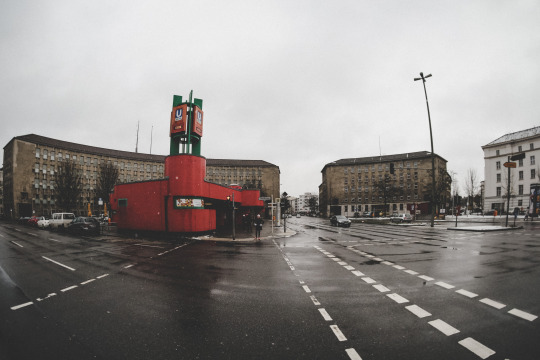
Fehrbelliner Platz
#espritmetropolphotography#fehrbelliner platz#hauptstadt#haltestelle#U-Bahn#U-Bahnhof#Fisheye#Berlin 2017
30 notes
·
View notes
Text
U3 - The urban subway
After crossing the Ring it becomes quite obvious that I am now in the city center. The buildings are closer together and consistently multiple stories tall. So from Heidelberger Platz I continue north-west.

[a calm side street in a residential neighborhood; green trees give plenty of shade to the sidewalk and the buildings painted in bright wight and yellow colors]
Similar to the U4 the U3 crosses through a valley halfway between Heidelberger Platz and Fehrbelliner Platz. And in fact this valley is a continuation of the one where the U4 station Rathaus Schöneberg is. But on the U3 there is no station here. Just a bridge over a small lake.

[view over a small lake that is entirely surrounded by green trees]

[a concrete bridge from the side; it has been decorated heavily with graffiti; below one of the arches of the bridge one can see dark, murky water; small ventilation holes reveal that the structure is hollow and hiding the subway from plain sight]
From there it is not far to the next station. Fehrbelliner Platz is where the U3 intersects the comparatively new U7. As a consequence the main station building is a very modern design and apparently there is a nuclear fallout shelter attached to this station. Some of the buildings around this square are used by the city for administration and in case of an attack the workers would evacuate to the station and shelter underground.

[a modern structure with stepped, flat roof pieces that have several rounded corners sits on the other side of a large street; most of the facade is tiled in bright red but a clock tower partially in bright green pokes over the rest of the station]
The line then continues under the Hohenzollerndamm to the station Hohenzollernplatz, both named for the dynasty that ruled over Prussia and then later the German Empire which then due to the incompetence of the Emperor supported Austria-Hungary in the July crisis of 1914 which then led to the first world war and the excruciating death of several million people. Maybe we should think about not naming nice places after awful people like that.

[a staircase to the underground with a station sign is framed by two sturdy rock pillars; on each pillar perches a stone eagle each looking in another direction, seemingly guarding the entrance]
Thematically fitting the next station on the line is Spichernstraße. Named for the small village of Spicheren in France, where a deciding battle in the Franco-German war of 1870 took place. After the German victory in said war, Wilhelm I was crowned emperor of Germany in the occupied Versailles.
Fortunately the place where this station is, is not nearly as grim. It’s a nice and green street with residential buildings and a few shops. The sidewalk is nice and wide and the bike lane forms a really pleasant to ride and safe way to use this straight street to get around.

[the stairs to the station is covered by a blue metal roof; two bikes are parked at frames right next to the entrance; large trees form a green roof for the whole street]
The next station is Augsburger Straße which shares this very simple, modern style of entrance. This station is in fact quite new compared to the rest, as it was opened in 1961 to replace the station Nürnberger Straße. The old station there was deemed too close to the station Spichernstraße which was connected to the U9 at around the same time.

[two stairs to the subway are on opposite sides of a street; each is framed by metal railings to prevent people falling in; a few trees stand in front of modern buildings; a few people mill about the intersection]
From there it is just a few street corners until one suddenly stands in the center of the City West. Wittenbergplatz, for which the station there is named is surrounded by busy stores. The beautiful station building sits right in the center of all the people going to the pricey stores. The U3 is truly a bit magical. With just a bit of time it can get you from a farm to a fancy upper-class department store.

[the station building is built in classical style and looks a bit like a Greek temple; large, blocky columns frame the doors and on window panes above the three entrances is written in golden letters: Bahnhof Wittenberplatz Untergrund Bahn; on a small lawn on the right stands a metal frame with signs; the top one reads: Orte des Schreckens, die wir niemals vergessen dürfen (transl: Places of horror, that we must never forget); the signs beneath list the names of concentration camps]

[a few along the Tauentzienstraße; on the left is the Kaufhaus des Westens, a fancy department store; in the distance among some high rises one can see the Kaiser Wilhelm memorial church, its top a gaping hole; the center of the street has a footpath and green space; thick red pipes snake across the street over the heads of people]
4 notes
·
View notes
Photo

West Berlin 1985. Public sculpture on the central reservation of Hohenzollerndamm. The U-Bahn station in the background is Fehrbelliner Platz.
61 notes
·
View notes
Text

U-Bahnhof Fehrbelliner Platz, Berlin
#bnw#freshfrompoland#black and white#berlin#modern architecture#architektura#modernism#modern#west berlin
4 notes
·
View notes
Photo
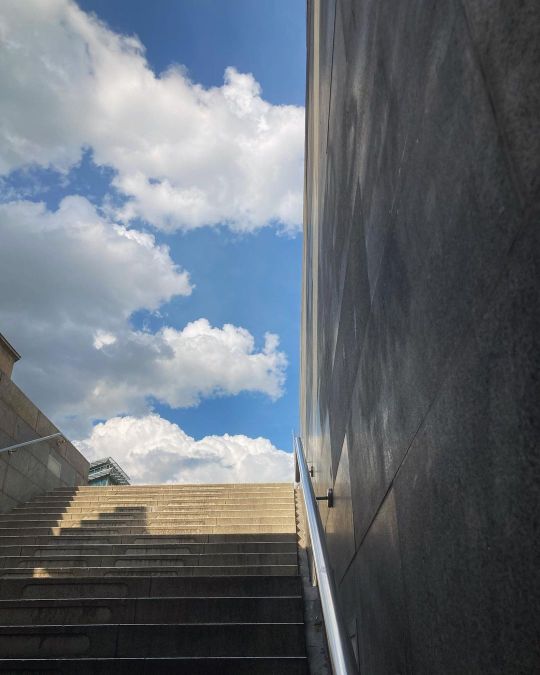
forever #cloudlove pt. 7352 (hier: U-Bahnhof Fehrbelliner Platz) https://www.instagram.com/p/CR2Enp7MRon/?utm_medium=tumblr
1 note
·
View note
Photo
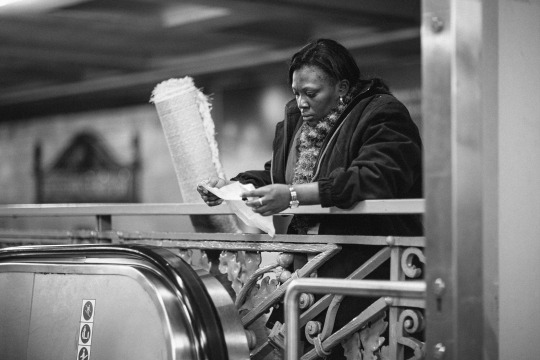
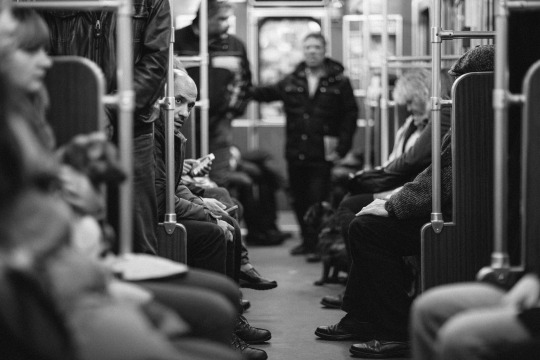
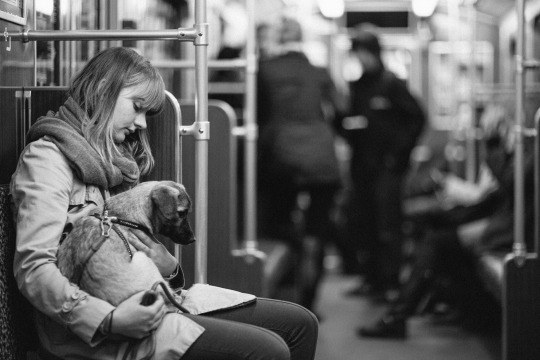
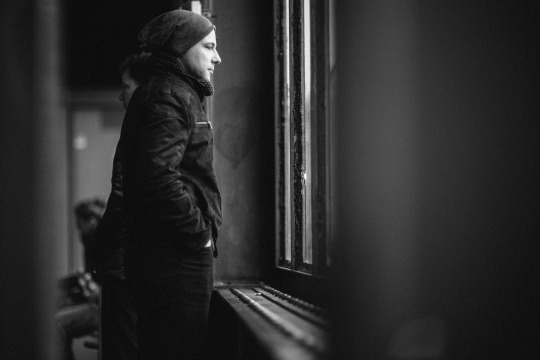
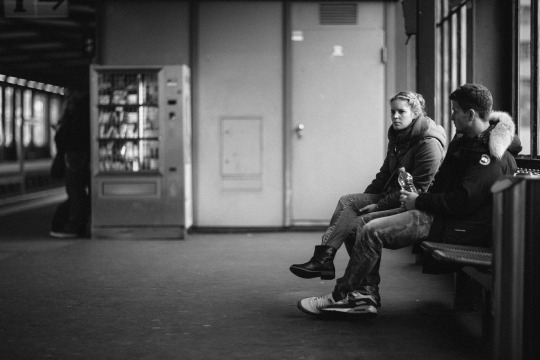
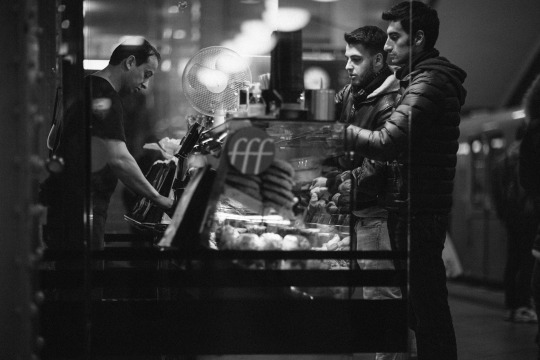
Berlin Wilmersdorf/Schöneberg/Mitte
U-Bahnhof Fehrbelliner Platz | U3 | U-Bahnhof Nollendorfplatz | U-Bahnhof Alexanderplatz
Canon EF 85mm f/1.2L II USM@Canon EOS 6D
#Canon EOS 6D#Canon EF 85mm f/1.2L II USM#germany#Deutschland#Wilmersdorf#Schöneberg#Mitte#U-Bahnhof Fehrbelliner Platz#U-Bahnhof Nollendorfplatz#U-Bahnhof Alexanderplatz#U3#U-Bahn#subway#underground#public transportation#ÖPNV#BVG#streetphotography#people#urban#city#metro#retro#vintage#monochrome#Depth Of Field#DOF#bokeh
1 note
·
View note
Photo

The office of architects Jan and Rolf Rave unquestionably belongs to the most important postwar practices in Berlin. With the Ruhleben Crematorium, one of their earliest projects, or the BfA on Fehrbelliner Platz the brothers designed key buildings of postwar modernism in Germany that were received way beyond German borders. Wolfgang Schäche’s book, published by Jovis Verlag in 2012, recounts the office’s history and presents the architects as sensitive designers who were well aware of current developments in architecture without ever being fashionable. Each stage of the office’s development is defined by introductory texts and exemplary buildings which make the book a vivid read about two key figures of contemporary (German) architectural history.
#jan rave#rolf rave#monograph#architecture book#architecture#germany#nachkriegsmoderne#nachkriegsarchitektur#book#book cover
44 notes
·
View notes
Photo

quartet on red
berlin wilmersdorf, 2017
#berlin#fehrbelliner platz#graphical#red#ubahn#urban#wilmersdorf#Photographers on tumblr#Original photographers
53 notes
·
View notes

